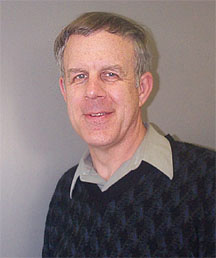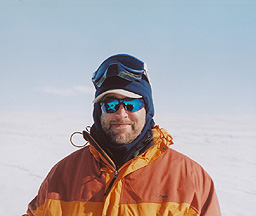 Program News
Program NewsCarlton Allen, JSC New Meteorites
This newsletter contains classifications for 283 new meteorites from the 1999, 2000, and 2001 ANSMET collections. They include samples from the Queen Alexandra Range, Bates Nunataks, Meteorite Hills, and Tentacle Ridge sites. Descriptions are given for 13 meteorites; 2 ureilites, 7 carbonaceous chondrites, 1 enstatite and 3 unequilibrated chondrites.
Lab Improvements
The JSC Antarctic Meteorite Lab is a much cleaner place than it used to be. Following replacement of the air handler, cleaning of the ductwork, and installation of HEPA filters the lab consistently meets the requirements for a Class 1,000 cleanroom.
The Lab will soon become a considerably more secure place in which to curate meteorites. In response to a recent theft from a Principal Investigator's lab, the physical security for all of JSC's astromaterials collections is being upgraded.
Antarctic Meteorite Curator
We have recently been given authorization by NASA to hire a permanent Curator for Antarctic Meteorites. We are looking forward, in the near future, to welcoming a new scientist to the JSC Curation team and continuing to improve our service to the meteorite research community
UPDATE on the Upcoming 2002-2003 ANSMET Field Season
Ralph Harvey, ANSMET
 As of this writing, we plan to operate two independent ANSMET field teams during the upcoming austral summer; one dedicated to systematic meteorite recovery from well-known icefields, and the other dedicated to high-level reconnaissance of some very promising (but difficult to reach) sites. Preparations for the fieldwork are well underway. Field party members have been selected and are undergoing their physical and dental examinations, buying good sunglasses and stockpiling books to read. The preliminary calendar of logistical support needs that Nancy Chabot and I submitted in April has been scrupulously reviewed, and we're actively gathering satellite imagery, maps and air photos of our targets. The situation is only a little more chaotic than normal; I've still not seen it written, on paper, that the second (NASA-funded) field team is approved for deployment by NSF. But unlike last year, everyone is plunging ahead on the assumption we'll make it work somehow. Details of the two field team plans are as follows.
As of this writing, we plan to operate two independent ANSMET field teams during the upcoming austral summer; one dedicated to systematic meteorite recovery from well-known icefields, and the other dedicated to high-level reconnaissance of some very promising (but difficult to reach) sites. Preparations for the fieldwork are well underway. Field party members have been selected and are undergoing their physical and dental examinations, buying good sunglasses and stockpiling books to read. The preliminary calendar of logistical support needs that Nancy Chabot and I submitted in April has been scrupulously reviewed, and we're actively gathering satellite imagery, maps and air photos of our targets. The situation is only a little more chaotic than normal; I've still not seen it written, on paper, that the second (NASA-funded) field team is approved for deployment by NSF. But unlike last year, everyone is plunging ahead on the assumption we'll make it work somehow. Details of the two field team plans are as follows.
Systematic searching team: NSF funding will support a team of 8 who will fly by LC-130 to paradoxically-named Beardmore South Camp at the north end of the Walcott Névé. This abandoned camp will be the starting point for an all-day snowmobile traverse southward across the Névé to Goodwin Nunataks and MacAlpine Hills. Goodwin Nunataks is one of the several icefields that serve as home for QUE specimens, and was last systematically searched in the 1999-2000 season, recovering more than 400 specimens. Only half of the exposed blue ice in this area was systematically searched. MacAlpine Hills is the home of the MAC specimens, lies to the north and west of Goodwin Nunataks, and was visited in the 1987 and 1988 seasons, with 126 meteorites recovered. However, those visits were short and systematic searching of the MacAlpine Hills icefields was limited. The weather, logistics and the workload will all determine how much time is spent at the various sites. At the end of the season, the team will traverse back to Beardmore South Camp for the pull-out. The systematic search team will be deployed for about 6 weeks, with both put-in and pull-out planned for a few days earlier than the reconnaissance team.
 The reconnaissance team: Using support from NASA we are putting together a smaller 4 person team that will be heavily supported by small aircraft (Twin Otter) to allow for a high degree of mobility and flexibility. The focus of this team will be to explore new or poorly known icefields, conducting "survey-level" searching and identifying their potential for future systematic work by a larger team. At the present time, we have not selected final targets; but the general region of activity will be out at the western end of the Transantarctic Mountains, with the team operating out of South Pole Station. Put-in and pull-out of this team will be a few days later than for the systematic searching team. This group will get to see some amazing sights, but will be travelling lean and sharing a heavier-than-normal physical workload.
The reconnaissance team: Using support from NASA we are putting together a smaller 4 person team that will be heavily supported by small aircraft (Twin Otter) to allow for a high degree of mobility and flexibility. The focus of this team will be to explore new or poorly known icefields, conducting "survey-level" searching and identifying their potential for future systematic work by a larger team. At the present time, we have not selected final targets; but the general region of activity will be out at the western end of the Transantarctic Mountains, with the team operating out of South Pole Station. Put-in and pull-out of this team will be a few days later than for the systematic searching team. This group will get to see some amazing sights, but will be travelling lean and sharing a heavier-than-normal physical workload.
If all goes as currently scheduled, the field team will depart the US and other points of origin in mid-November, reach McMurdo Station, Antarctica about 4 days later, and get into the field near the first of December. Everyone should be on their way back to civilization by the end of the third week of January, 2003.